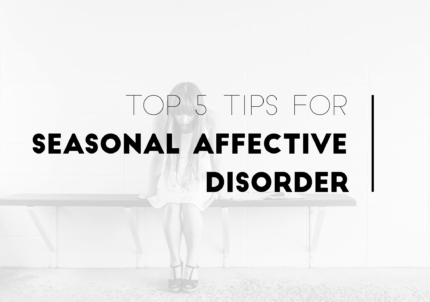We’re at the beginning of February and the days are slowly but surely getting longer. The differences are subtle but many of us hang on to the one minute of extra sunlight as if it were life.
Have you also noticed that you don’t feel like yourself during the winter months? You’ve heard of the ‘winter blues’ and that’s actually exactly how you feel. I want you to know you’re not alone! Longer periods of darkness and the cold weather in Canada pose a problem for us.
If you experience this, you may be experiencing seasonal affective disorder (SAD). The ‘winter blues’ affect 15% of Canadians each year and 2-6% of Canadians experience SAD specifically.1 No fear, I’m going to explain what it is and my top tips to make you feel like yourself again.
Symptoms of SAD
When it comes to the difference between SAD and winter blues it is really just the severity of symptoms. All of the symptoms listed below exist on a spectrum and when these affect your daily life it is more likely SAD
- Less energy
- Trouble concentrating
- Fatigue
- Greater appetite
- Desire to be alone
- Greater need for sleep
- Weight gain
What causes SAD?
Everyday we are influenced by a 24-hour cycle called our circadian rhythm that is regulated by sunlight during the day and darkness at night. Not only does our circadian rhythm affect our sleep-wake time, it affects systems like our hormones, eating patterns and mood. One of the main causes of SAD is the disruption of circadian rhythm by the long, dark days of the winter months. Another theory is that with less sun exposure we make less serotonin, which is the ‘happy hormone’ that those with clinical depression often use medication to experience more of.
Our vitamin D levels may also contribute to SAD. With a decrease in sunlight during the winter months we’re not producing as much vitamin D. Although we don’t know how yet, there is a clear connection between vitamin D deficiency and depressive symptoms as seen in SAD.2
My 5 Top Tips
-
Get sunlight in the morning
The moment that light hits our eyes in the morning we get a spike in cortisol. Cortisol is a stress hormone, but it also a key hormone involved in energy production, mental clarity and that ‘get up and go feeling in the morning.
In the winter, when we are getting less sunlight, make sure to open your blinds or step outside without sunglasses in the morning. This supports a proper cortisol spike.
-
No phones at night
This is easier said than done, but it’s worth it! Give yourself an hour before bed to place your phone in another room for the night. The blue light emitted from our electronic devices suppresses melatonin – the hormone that increases at night to put us to sleep.3 I like to set a reminder on my phone an hour and a half before bedtime to make sure I can finish up any activities before turning it off for the night.
-
Buy wake up light or Happy Lamp
This goes back to my first tip. In the winter months or if you don’t have windows in your room, a wake up light or Happy Lamp are two great ways to increase cortisol production. Seeing as our circadian rhythm is a cycle, it’s important to ensure that this cycle remains fairly consistent so our body is regulated all year long. By using either of these devices you can set it for the same time every day so your body stays on track. 15-20 minutes while you are getting ready in the morning is all you need.
-
Check vitamin D levels
Like I explained before, a vitamin D deficiency may actually be a cause of SAD. A simple blood test can let you know not only if you are deficient, but how much vitamin D you should be supplementing with to increase your levels to a normal range.
-
Support your serotonin
Low serotonin levels can cause depression, low energy, carb cravings and many more symptoms. Although I don’t recommend taking supplements to increase your serotonin without a doctor’s advice there are many lifestyle things you can do. Eating enough protein (at least 3 servings per day) and cutting sugar are two main places to start. Protein helps to support serotonin synthesis and sugar can actually work against this. Also exercising, getting massages making a regular habit of stretching or taking baths will get you on your way.
If you experience SAD, you’re not alone. You don’t have to dread the winter months because there are simple and effective ways to help. I’ve given you my 5 top tips that you can do yourself, but there’s always more we can do. When you feel empowered to take the next step book an appointment with me and we can get you feeling back to normal.
References:
- MOOD Ontario. Seasonal Affective Disorder. https://www.mooddisorders.ca/faq/seasonal-affective-disorder-sad. Accessed January 19, 2018.
- Melrose S. Seasonal Affective Disorder: An Overview of Assessment and Treatment Approaches. Depress Res Treat. 2015;2015:1-6. doi:10.1155/2015/178564.
- Shechter A, Kim EW, St-Onge M-P, Westwood AJ. Blocking nocturnal blue light for insomnia: A randomized controlled trial. J Psychiatr Res. 2018;96:196-202. doi:10.1016/j.jpsychires.2017.10.015.

